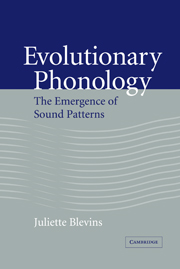11 - Beyond phonology
Published online by Cambridge University Press: 22 September 2009
Summary
Our ignorance of the laws of variation is profound.
Darwin (1859)The previous chapters present a sustained argument that many common sound patterns are the result of parallel evolution. Certain sound changes are frequent due to intrinsic properties of speech: some sounds or sound sequences are more likely to be misperceived than others (change); certain features with long temporal domains are harder to localize than others (chance); and inherent variation along the careful/casual or hyper-to-hypoarticulated speech continuum gives rise to variants with multiple categorical interpretations (choice). A plausible working hypothesis is that all regular spontaneous sound changes fall into one or more of these categories. Moreover, from this perspective, once historical explanations are found for common sound patterns, the same phonetic explanations need not, and indeed should not, be encoded in synchronic grammars. Synchronic grammars show no bifurcation of “natural” versus “unnatural” phonological alternations. Regular alternations are learned quickly and easily. Exceptionless alternations are typically productive. However, as summarized in chapter 9, there is only a tendency for surface-true generalizations to directly reflect natural sound change. There is no evidence that phonetic explanations play any role in synchronic phonological systems, and certain “marked” segment types and sound patterns appear to be no more unstable, historically, than unmarked ones.
If the language faculty is an integrated (cognitive) system, with multiple subcomponents, as suggested by decades of accumulated data on language deficits (Kean 1985; Caplan 1987; Bates and Wulfeck 1989; Grodzinsky 1990; Clahsen 1999) and lexical priming (Katz et al. 1987; Marslen-Wilson et al. 1993, 1994), and if an evolutionary view is on the right track, then one might expect to find historical explanations for distributional patterns of other linguistically significant units.
- Type
- Chapter
- Information
- Evolutionary PhonologyThe Emergence of Sound Patterns, pp. 300 - 314Publisher: Cambridge University PressPrint publication year: 2004



